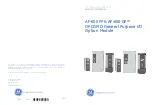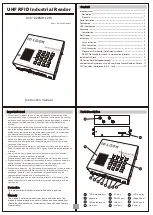
765-1205/100-000
Appendix
Product manual | Version: 2.0.0
115
8DIO FLD EC DC 24V 2.0A
AoE NetId
The EtherCAT master assigns an AoE NetId to each EtherCAT slave in its network,
through which the EtherCAT slave can be identified as a sender or receiver of AoE pack-
ets.
The AoE NetId consists of six bytes. It can be freely chosen and must be unique within
the AoE network. Example of an AoE NetId: 174.15.18.10.2.1.
The AoE NetId is a logical specification and not an IP address, but may include the IP ad-
dress for easier identification.
Only the EtherCAT communication
uses the
AoE NetId of the EtherCAT slave
.
For EtherCAT slaves with integrated IO-Link functionality like the EtherCAT IO-Link gate-
way, the EtherCAT master additionally assigns a
second AoE NetId
to the EtherCAT
slave;
only the IO-Link communication
uses this.
14.1.1.2 Addressing the Objects in IO-Link Devices via AoE
In AoE, the following applies for addressing the objects of connected IO-Link devices:
• For addressing, AoE uses the parameters PortNumber, IndexGroup and IndexOffset
(32 bits each).
• The assignment of the port number to the IO-Link port is shown in the following table:
Table 82: Assignment of AoE Port Numbers to IO-Link Ports
Port Number
IO-Link Port
0x1001
Port 1
0x1002
Port 2
0x1003
Port 3
...
...
0x1008
Port 8
• IndexGroup has the fixed value 0xF302.
• IndexOffset specifies the index and the subindex of the object of the IO-Link device
connected to the IO-Link master port. The
IndexOffset
parameter contains the index
and subindex.
Table 83: IndexOffset Parameter for Addressing the IO-Link Object
Bits
Contents
Bits 16 ... 31
Index (16 bit value)
Bits 8 ... 15
Fixed value 0
Bits 0 ... 7
Subindex (8 bit value)
14.1.2 AoE – Transfer of ADS Data in the Mailbox of the EtherCATFrame
EtherCAT offers the option of integrating other protocols via a mailbox. The data of these
protocols is written into the mailbox area in the EtherCAT frame.
With AoE, protocol data of the ADS protocol is transmitted in the mailbox area. ADS is in-
tegrated into the EtherCAT frame in this way, as the following figure shows.
















































